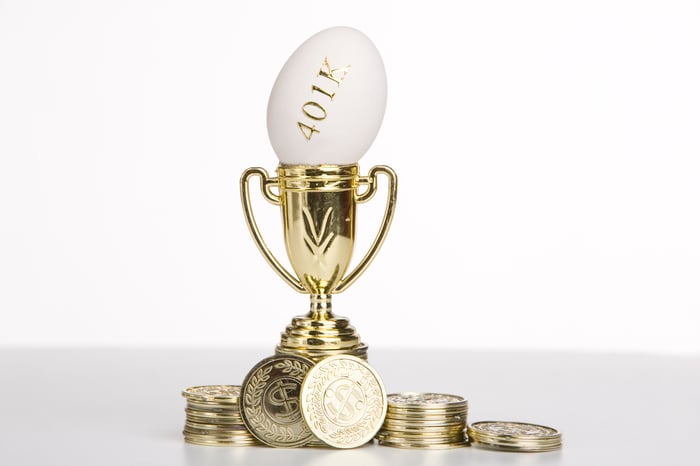Even if you've never actively bought a stock, bond, or mutual fund, your money is being invested. The problem is that in most cases, if you're not the one directly doing the investing, then whoever is investing your money is probably reaping much of the reward from it.
To be able to reap some of those rewards for yourself, you need to be the one directing where and how your money is invested -- and do so such that it's invested on your behalf. With that in mind, here are three ways you're already investing, and how to invest more of your money for yourself.

Image source: Getty Images.
No. 1: Money in the bank
When you put money in your bank account, it doesn't just sit there. The bank lends most of it out to borrowers, typically through things like mortgages, credit cards, or personal loans. The difference between the interest rate it pays you on the money you deposit and the rate it charges the people who borrow from it serves as a key pillar of its profit.
These days, many checking accounts at banks don't pay interest at all, and those that do generally don't offer more than around 0.15%. Contrast that with mortgage rates that are above 3.1% for a 30-year mortgage or credit card rates above 16%, and you can start to see how those banks are earning their keep.
Of course, you do need a certain amount of cash available to pay your bills and a bit more socked away for emergencies, and a bank is a reasonable place to keep that type of cash. For money you're not expecting to need to spend anytime soon, however, you can consider investing it in the stocks of banks or other credit card issuers. That way, you have a chance of profiting along with your lenders, instead of just providing them the financing they use to drive those profits.
No. 2: Social Security

Image source: Getty Images.
Every time Social Security taxes are deducted from your paycheck or sent in from your self-employment earnings, those payments help maintain a trust fund that has grown to around $2.9 trillion. Although that trust fund is expected to run out of money by 2035, that projection is due to the cost of paying benefits dramatically outpacing the program's revenue. The trust fund's assets themselves remain invested in U.S. Treasury securities, generally considered among the safest investments in the world .
Those Treasuries are considered safe for two key reasons. First, they're backed by the U.S. government's power to tax. Second, they're denominated in U.S. dollars, a currency controlled by the same U.S. government that's borrowing the money in the first place. In a worst-case scenario, the government could just print more dollars to satisfy that debt obligation. While that type of currency printing could lead to inflation, the original debt would still get completely paid as agreed.
Social Security gets paid interest on its Treasury investments, and those interest payments help keep the trust fund from running out as quickly as it would if it simply held cash. Treasuries are also available in the market for individual investors, and there are some decent reasons to invest in them directly instead of relying only on Social Security to get some sort of exposure to them.
First and foremost, you get the same reasons to believe that the Treasury will make good on its commitment to pay you as scheduled that Social Security does. In addition, unlike Social Security, Treasuries you own are your property that you can sell if you need cash or leave to your heirs as inheritance. That makes them far more flexible than Social Security's monthly benefit.
No. 3: Your 401(k) or other employer-sponsored retirement plan

Image source: Getty Images.
Many employers now automatically enroll employees in the company's 401(k) or other employer-sponsored retirement plan. If yours does, you may be investing without even realizing you are. If there's a downside to it, it's that automatic enrollment provisions generally cover only a small percentage of your salary and are frequently tied to fairly conservative choices within the plan. Still, they represent a good start on your investing journey.
In most cases, you can invest more than that minimum initial amount, and doing so can provide an incredible base upon which you can build wealth for your long term future. Indeed, it's quite possible to become a millionaire simply by investing enough for a long enough time in your 401(k) and letting compounding work its magic on your behalf over that time. At minimum, you should figure out how to increase your contribution enough to get the maximum match your employer offers.
In the event you can't put more money into your employer sponsored plan, as long as you have earned income, you should be able to contribute to an Individual Retirement Account (IRA). Although the contribution limits are lower in an IRA than in most employer-sponsored plans, IRAs generally provide more flexibility and often offer access to lower cost investments.
Your money is being invested: Benefit from it
As you can tell by the first two ways, unless you bury your cash in a coffee can in your backyard or hide it under your mattress, somebody somewhere is probably already investing that cash. To have your best chance of seeing the rewards from that investing, you should be the one directing where your cash goes. The more of your money you put to work for you, the higher the likelihood you'll wind up financially comfortable when all is said and done.




